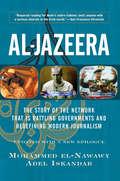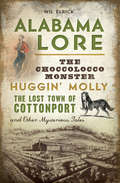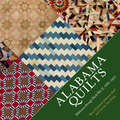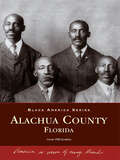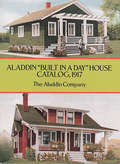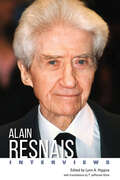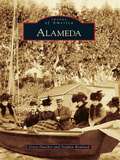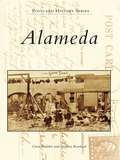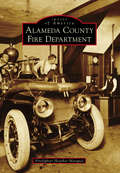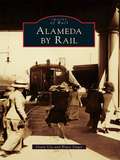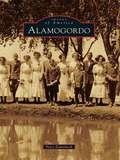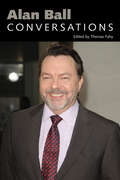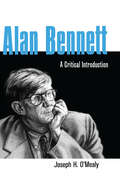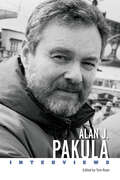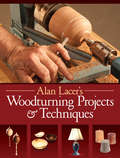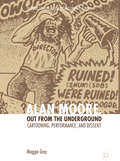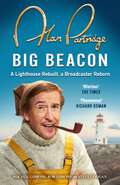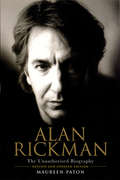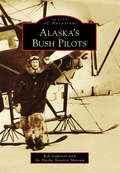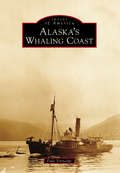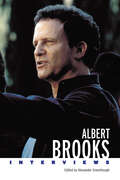- Table View
- List View
Al Roker’s Recipes to Live By: Easy, Memory-Making Family Dishes for Every Occasion
by Al Roker Courtney Roker LagaBarnes & Nobles Most Anticipated Comfort Food BooksTODAY Show cohost and America&’s favorite weatherman, Al Roker, and his daughter, Courtney Roker Laga, welcome us into their kitchen in this cookbook featuring generations-long family favorites for every meal. Al Roker and his daughter, Courtney Roker Laga, welcome you into their home, where a good conversation or a needed dose of laughter always starts with something great to eat. 100 original and kitchen-tested dishes for every occasion, including Sunrise Burritos Shrimp and Grits with Bell Peppers and Bacon Smothered Chicken Coffee- and Spice-Rubbed Pork Chops Christmas Morning Cinnamon Rolls Bourbon Apple Pie Milkshakes Tuscan Polenta Silky Cauliflower Puree Lemon Meringue Crumb Crust Pie Stunning dishes in this book will inspire you to start cooking memory-making meals. Full of cheerful family photos and Al&’s frank, witty opinions on food and cooking, Al Roker&’s Recipes to Live By is sure to become the most well-thumbed cookbook on your shelf, whether you&’re a beginner home cook or a seasoned chef.
Al-Jazeera: The Story of the Network that is Rattling Governments and Redefining Modern Journalism
by Mohammed El-Nawawy Adel IskandarAl-Jazeera, the independent, all-Arab television news network based in Qatar, emerged as ambassador to the Arab world in the events following September 11, 2001. Arabic for "the island," Al-Jazeera has "scooped" the western media conglomerates many times. With its exclusive access to Osama Bin Laden and members of the Taliban, its reputation was burnished quickly through its exposure on CNN. During the 2003 war in Iraq, Al-Jazeera seemed to be everywhere, reporting dramatic stories and images, even as it strived to maintain its independence as an international free press news network. Al-Jazeera sheds light on the background of the network: how it operates, the programs it broadcasts, its effects on Arab viewers, the reactions of the West and Arab states, the implications for the future of news broadcasting in the Middle East, and its struggle for a free press and public opinion in the Arab world.
Alabama Gold: A History of the South’s Last Mother Lode
by Peggy Jackson WallsGold rushes in Cleburne and Tallapoosa Counties attracted thousands of miners years before California's famous strike. In 1936, production at the Hog Mountain mine caused Alabama to be recognized as the top producer in the Appalachian states. In Hog Mountain's heyday, a local German settler discovered the precious metal while digging a wine cellar. In Log Pit, unscrupulous speculators "shot" ore into rock crevices and "salted" nuggets on land to enhance its sale value. A Cleburne County miner cleaned over eleven pounds of gold and was killed in a "free fight" all in one day. Join author Peggy Jackson Walls as she traces a century of gold mining in Alabama.
Alabama Lore: The Choccolocco Monster, Huggin' Molly, the Lost Town of Cottonport and Other Mysterious Tales
by Wil ElrickAlabama is a weird and wonderful place with a colorful history steeped in folk tales passed from generation to generation. Mysterious 1989 UFO sightings brought more than 4,000 visitors to the tiny town of Fyffe, population 1,300. Legends of the Alabama White Thang--an elusive, hairy creature with a shrill shriek--persisted in the state for a century. Just outside Huntsville's historic Maple Hill Cemetery lies an eerie playground where the ghosts of departed children are rumored to play in the dead of night. After hundreds of unexplained sightings, the town of Evergreen declared itself the Bigfoot Capital of Alabama. Join author Wil Elrick as he explores the history behind some of the Cotton State's favorite tales.
Alabama Quilts: Wilderness through World War II, 1682-1950
by Mary Elizabeth Johnson Huff Carole Ann KingWinner of the 2022 James F. Sulzby Book Award from the Alabama Historical AssociationAlabama Quilts: Wilderness through World War II, 1682–1950 is a look at the quilts of the state from before Alabama was part of the Mississippi Territory through the Second World War—a period of 268 years. The quilts are examined for their cultural context—that is, within the community and time in which they were made, the lives of the makers, and the events for which they were made. Starting as far back as 1682, with a fragment that research indicates could possibly be the oldest quilt in America, the volume covers quilting in Alabama up through 1950. There are seven sections in the book to represent each time period of quilting in Alabama, and each section discusses the particular factors that influenced the appearance of the quilts, such as migration and population patterns, socioeconomic conditions, political climate, lifestyle paradigms, and historic events. Interwoven in this narrative are the stories of individuals associated with certain quilts, as recorded on quilt documentation forms. The book also includes over 265 beautiful photographs of the quilts and their intricate details. To make this book possible, authors Mary Elizabeth Johnson Huff and Carole Ann King worked with libraries, historic homes, museums, and quilt guilds around the state of Alabama, spending days on formal quilt documentation, while also holding lectures across the state and informal “quilt sharings.” The efforts of the authors involved so many community people—from historians, preservationists, librarians, textile historians, local historians, museum curators, and genealogists to quilt guild members, quilt shop owners, and quilt owners—making Alabama Quilts not only a celebration of the quilting culture within the state but also the many enthusiasts who have played a role in creating and sustaining this important art.
Alachua County, Florida (Black America Series)
by Lizzie Prb JenkinsAlachua County's African American ancestry contributed significantly to the area's history. Onceenslaved pioneers Richard and Juliann Sams settled in Archer as early as 1839. They were former slaves of James M. Parchman, who journeyed through the wilderness from Parchman, Mississippi. They and others shaped the county's history through inventions, education, and work ethics based on spirituality. This book shows people working together, from the early1800s rural farm life, when racial violence was routine, until African Americans broke the chains of injustice and started organizing and controlling civic affairs.
Aladdin "Built in a Day" House Catalog, 1917 (Dover Architecture)
by Aladdin CompanyDesigns for 60 homes, from a simple four-room cottage with a front porch to a comfortable two-story home with four bedrooms, a reception hall, and pantry. Shown in landscaped exteriors, floor plans, and overhead cutaway views. With detailed commentaries on each design.
Alain Resnais: Interviews (Conversations with Filmmakers Series)
by T. Jefferson KlineAmong the most innovative and influential filmmakers of the twentieth century, Alain Resnais (1922–2014) did not originally set out to become a director. He trained as an actor and film editor and, during the sixty-eight years of his working life, delved into virtually every corner of filmmaking, working at one time or another as screenwriter, assistant director, camera operator and cinematographer, special effects coordinator, technical consultant, and even author of source material. From such award-winning documentaries as Van Gogh and Night and Fog to the groundbreaking dramas Hiroshima mon amour, Last Year at Marienbad, and Muriel, Resnais’s films experiment with such themes as consciousness, memory, and the imagination. Distinguishing himself from associations with the French New Wave movement, Resnais considered his films to be “anti-illusionist,” never allowing his spectators to forget they were watching a work of art. In Alain Resnais: Interviews, editor Lynn A. Higgins collects twenty-one interviews with the filmmaker, twelve of which are translated into English for the first time. Spanning his entire career from his early short subjects to his final feature film, the volume highlights Resnais’s creative strategies and principles, illuminates his place in world cinema history, and situates his work relative to the New Wave, American film, and experimental filmmaking more broadly. Like his films, the interviews collected here reveal a creator who is at once an intellectual, a philosopher, an entertainer, a craftsman, and an artist.
Alameda
by Stephen Rowland Greta DutcherAlameda was once a peninsula of grassy fields and sandy beaches, separated from Oakland by a snaking estuary. A tidal canal made Alameda an island in 1902 and its waterfront became a major shipping port. Park Street's bay-windowed commercial buildings looked out on a prosperous city of streetcars and comfortable homes. Between the two world wars, Alameda's Neptune Beach resort and amusement park became the "Coney Island of the West," eventually boasting a Moorish entrance tower on Webster Street, a stadium, two swimming pools, a high dive, and a roller coaster called the "Whoopie." Alameda's strategic location made its "airdrome" the busiest in the world in the 1930s and eventually attracted a U.S. Coast Guard base, known as Government Island, and the Alameda Naval Air Station.
Alameda (Postcard History Series)
by Stephen Rowland Greta DutcherAlameda was once a peninsula of grassy fields and sandy beaches, separated from Oakland by a snaking estuary. A tidal canal made Alameda an island in 1902 and its waterfront became a major shipping port. Park Street�s bay-windowed commercial buildings looked out on a prosperous city of streetcars and comfortable homes. Between the two world wars, Alameda�s Neptune Beach resort and amusement park became the �Coney Island of the West,� eventually boasting a Moorish entrance tower on Webster Street, a stadium, two swimming pools, a high dive, and a roller coaster called the �Whoopie.� Alameda�s strategic location made its �airdrome� the busiest in the world in the 1930s and eventually attracted a U.S. Coast Guard base, known as Government Island, and the Alameda Naval Air Station.
Alameda County Fire Department (Images of America)
by Firefighter Heather MarquesAlameda County spans from the shores of the San Francisco Bay to the golden inland hills. Alameda County Fire Department (ACFD) is comprised of multiple consolidated agencies that began joining forces and sharing resources in 1993. Protecting unincorporated county land as well as Ashland, Cherryland, San Lorenzo, Castro Valley, San Leandro, Dublin, Union City, Newark, Emeryville, and the National Laboratories at Livermore and Berkeley, ACFD serves over 500 square miles and 330,000 citizens. This legacy stretches back 140 years, recalling the shared experiences of bucket brigades, teams of horses pulling steam-engine pumpers down muddy roads, the advent of motorized apparatus, and the days when school boys would be pulled from class to ride tailboard to fight blazes in the hills. These agencies have sent soldiers to two world wars, survived massive earthquakes, fought catastrophic wildfires, and touched the lives of Bay Area citizens for over a century. The ACFD is the sum of its many unique parts, which together form a premier, all-risk fire department.
Alameda by Rail
by Bruce Singer Grant UteAcross the great bay from San Francisco, the city of Alameda evolved into an island hometown of fine Victorian and Craftsman architecture and a port containing a naval air station, shipbuilding center, and the winter home of the long-gone Alaska Packers fleet of "tall ships." But Alameda also was a busy railroad town. In 1864, a passenger railroad with a ferry connection created a commute to San Francisco. In 1869, the city became the first Bay Area terminus of the Transcontinental Railroad. Alameda became an island because a railroad allowed construction crews to dig a tidal canal, separating it from Oakland in 1902. Later generations rode steam, then electric, trains to a grand ferry pier where ornate watercraft guided them the 20 minutes to San Francisco. An auto tube, and later the San Francisco Oakland Bay Bridge, hastened the demise of ferry, then rail, operations before World War II.
Alamogordo
by Peter L. EidenbachIn 1898, the El Paso and Northeastern Railroad established New Mexico's first preplanned development community at Alamogordo. This city and its satellite communities of Tularosa, La Luz, and Cloudcroft are the only urban settlements in an area almost as large as Connecticut--the vast deserts and mountains of the Tularosa Basin are where people "climb for water and dig for wood." Alamogordo became the county seat after Otero County was created to modify the trial venue for the murder of Albert Fountain and his son Henry. West Texas ranching families moved into the Tularosa Basin in the 1880s and depended on ranching, farming, and tourism until World War II led to the creation of the Alamogordo Army Air Field (Holloman Air Force Base) and White Sands Proving Ground, the birthplace of the U.S. space and missile program. The first atomic explosion, Trinity, took place in White Sand's northwest corner on July 16, 1945. Col. John Stapp, pioneer of aerospace medicine, rode rocket sleds at the Holloman Test Track, leading to modern automotive seat belts.
Alan Ball: Conversations (Television Conversations Series)
by Thomas FahyAlan Ball: Conversations features interviews that span Alan Ball's entire career and include detailed observations and insights into his Academy Award-winning film American Beauty and Emmy Award-winning television shows Six Feet Under and True Blood. Ball began his career as a playwright in New York, and his work soon caught the attention of Hollywood television producers. After writing for the sitcoms Grace Under Fire and Cybill, Ball turned his attention to the screenplay that would become American Beauty. The critical success of this film opened up exciting possibilities for him in the realm of television. He created the critically acclaimed show Six Feet Under, and after the series finale, he decided to explore the issue of American bigotry toward the Middle East in his 2007 play All That I Will Ever Be and the film Towelhead, which he adapted and directed in the same year. Ball returned to television once again with the series True Blood—an adaptation of the humorous, entertaining, and erotic world of Charlaine Harris’s vampire novels. In 2012 Ball announced that he would step down as executive producer of True Blood, in part, to produce both a new television series and his screenplay, What’s the Matter with Margie?
Alan Bennett: A Critical Introduction (Studies in Modern Drama)
by Joseph O'MealyAlan Bennett is perhaps best known in the UK for the BBC production of his Talking Heads TV plays, while the rest of the world may recognize him for the film adaptation of his play, The Madness of King George. O'Mealy points out that Bennett is a social critic strongly influenced by Beckett and Swift, interested in depicting and analyzing the role playing of everyday life, a'la sociologist Ervin Goffman.
Alan J. Pakula: Interviews (Conversations with Filmmakers Series)
by Tom RyanRenowned for his masterful storytelling, Alan J. Pakula (1928–1998) left an indelible mark on cinema history. Alan J. Pakula: Interviews offers a concise yet comprehensive overview of the director’s illustrious career, from his early days in Hollywood to his rise as a major filmmaker. From the famous “paranoia trilogy” of Klute, The Parallax View, and All the President’s Men to the gripping psychological drama of Sophie’s Choice and his often-undervalued later work, Pakula’s diverse filmography has captivated audiences and critics alike. The first published collection of interviews with the acclaimed director, this volume presents an illuminating portrait of Pakula as a filmmaker, an artist, and a man of many parts. The eighteen pieces compiled here, including an illuminating introduction and previously unpublished 1983 interview by editor Tom Ryan, provide a broad overview of Pakula’s career. In his own words, Pakula recounts his experience as Robert Mulligan’s producer, reflects on the bulk of films he made as director, and outlines his approach to the art of filmmaking. Taken as a whole, Alan J. Pakula: Interviews is a treasure trove of cinematic wisdom and a fitting tribute to the legacy of an important American filmmaker.
Alan Lacer's Woodturning Projects & Techniques
by Alan LacerSelected from more than 15 years of articles from one of the country's top turners, Alan Lacer's Woodturning Projects & Techniques has everything you need to learn to turn and take your lathe skills to the next level.This book includes an in-depth look at techniques, tools and chucks that will help perfect your core turning skills. You'll learn the right tools to use, how to handle them safely and how to maintain them. Lacer's expert instruction helps you master the bowl gouge, the spindle-roughing gouge, the skew and other essential turning tools. You'll also gain insight into finishing techniques, French polishing and working with spalted wood.Once you've sharpened your skills with the Tools & Techniques section, put your new knowledge to the test with 20 beautiful projects covering a wide range of turned forms and turning techniques.Sharpen your end-grain hollowing skills by turning a lovely wine gobletPractice turning spheres by creating your own bocce ball lawn gameGain insight into making multiples by turning matching table legsTurn a table lamp to practice flowing contoursLearn how to work with green wood by making a natural-edge bowlAnd much more!Complete with expert instruction, step-by-step photos, guides to sources and materials and tips for avoiding common pitfalls, this book is sure to help you improve your turning craft - and make some stunning pieces in the process.
Alan Moore, Out from the Underground: Cartooning, Performance, and Dissent (Palgrave Studies in Comics and Graphic Novels)
by Maggie GrayThis book explores Alan Moore's career as a cartoonist, as shaped by his transdisciplinary practice as a poet, illustrator, musician and playwright as well as his involvement in the Northampton Arts Lab and the hippie counterculture in which it took place. It traces Moore's trajectory out from the underground comix scene of the 1970s and into a commercial music press rocked by the arrival of punk. In doing so it uncovers how performance has shaped Moore's approach to comics and their political potential. Drawing on the work of Bertholt Brecht, who similarly fused political dissent with experimental popular art, this book considers what looking strangely at Alan Moore as cartoonist tells us about comics, their visual and material form, and the performance and politics of their reading and making.
Alan Partridge: The hilarious new memoir from the nation's favourite broadcaster
by Alan Partridge'There are prizes, normally named after PG Wodehouse, given to literary comic novels and non-fiction, and these books will have blurbs saying "hilarious" on them. This is infinitely funnier than any of them' DAVID BADDIEL'The funniest series of books ever written in the English language' RICHARD OSMAN'Hilarious' THE TIMES'Absolute f**king genius' CAITLIN MORAN'With a genuine belly laugh to be found on almost every page, it only cements Partridge's status as the world's greatest comedy character' EMPIRE'Partridge... has become the man our time deserves. Aha!' THE TIMES'This is a deeply silly book. It's also glorious...[with] proper belly laughs on pretty much every page' i NEWS'Every sentence screams pure Partridge...a spoof that comes close to comic genius' DAILY EXPRESS'Expect plenty of laughs' HEAT'Not only has Alan Partridge created an entirely new storytelling structure, it's very funny indeed' JON RONSON In Big Beacon, Norwich's favourite son and best broadcaster, Alan Partridge, triumphs against the odds. TWICE.Using an innovative 'dual narrative' structure you sometimes see in films, Big Beacon tells the story of how Partridge heroically rebuilt his TV career, rising like a phoenix from the desolate wasteland of local radio to climb to the summit of Mount Primetime and regain the nationwide prominence his talent merits. But then something quite unexpected and moving, because Big Beacon also tells the story of a selfless man, driven to restore an old lighthouse to its former glory, motivated by nothing more than respect for a quietly heroic old building that many take for granted, which some people think is a metaphor for Alan himself even though it's not really for them to say.* Leaving his old life behind and relocating to a small coastal village in Kent, Alan battles through adversity, wins the hearts and minds of a suspicious community, and ultimately shows himself to be a quite wonderful man. * The two strands will run in tandem, their narrative arcs mirroring each other to make the parallels between the two stories abundantly clear to the less able reader.
Alan Partridge: The hilarious new memoir from the nation's favourite broadcaster
by Alan Partridge'There are prizes, normally named after PG Wodehouse, given to literary comic novels and non-fiction, and these books will have blurbs saying "hilarious" on them. This is infinitely funnier than any of them' DAVID BADDIEL'The funniest series of books ever written in the English language' RICHARD OSMAN'Hilarious' THE TIMES'Absolute f**king genius' CAITLIN MORAN'With a genuine belly laugh to be found on almost every page, it only cements Partridge's status as the world's greatest comedy character' EMPIRE'Partridge... has become the man our time deserves. Aha!' THE TIMES'This is a deeply silly book. It's also glorious...[with] proper belly laughs on pretty much every page' i NEWS'Every sentence screams pure Partridge...a spoof that comes close to comic genius' DAILY EXPRESS'Expect plenty of laughs' HEAT'Not only has Alan Partridge created an entirely new storytelling structure, it's very funny indeed' JON RONSON In Big Beacon, Norwich's favourite son and best broadcaster, Alan Partridge, triumphs against the odds. TWICE.Using an innovative 'dual narrative' structure you sometimes see in films, Big Beacon tells the story of how Partridge heroically rebuilt his TV career, rising like a phoenix from the desolate wasteland of local radio to climb to the summit of Mount Primetime and regain the nationwide prominence his talent merits. But then something quite unexpected and moving, because Big Beacon also tells the story of a selfless man, driven to restore an old lighthouse to its former glory, motivated by nothing more than respect for a quietly heroic old building that many take for granted, which some people think is a metaphor for Alan himself even though it's not really for them to say.* Leaving his old life behind and relocating to a small coastal village in Kent, Alan battles through adversity, wins the hearts and minds of a suspicious community, and ultimately shows himself to be a quite wonderful man. * The two strands will run in tandem, their narrative arcs mirroring each other to make the parallels between the two stories abundantly clear to the less able reader.
Alan Rickman: The Unauthorised Biography
by Maureen PatonIn this revised and updated biography, Maureen Paton encompasses the private, professional and political life of this most enigmatic, charismatic and intensely private of actors.
Alanatomy: The Inside Story
by Alan Carr***If you loved Alan's first memoir - Look Who It Is! - then his follow-up, Alanatomy, will take you further into the hilarious and bizarre world of the country's favourite chatty man.***'As laugh out loud as his TV shows' Daily MirrorIt must seem strange to you that I've called a book Alanatomy . . . For anyone who has taken the time to see my stand-up performances or watched my chat show, 'Chattyman', knows that my body has hardly been kind to me - in fact there've been times when we've actually stopped talking to each other. Balding, myopic, often flaky with psoriasis, back fat that hangs suspended like a cape, a voice that could strip varnish, an increasingly dodgy hip and even dodgier teeth. Why would you draw attention to it? you must ask. Couldn't you just call the book something else? Do you think the Great British Public is ready to pore over your body? Well, as I turn forty and take stock of my showbiz life over the last ten years or so, I have learnt to embrace my flaws and face my shortcomings. In fact, strange as it might seem, the things I hate about myself have become my trademark and I am slowly, begrudgingly learning to, if not love them, to at least live with them. I am ready now to take a long hard look at myself and that's what Alanatomy is. It's the story of my rise to fame: the joys, the traumas, the parties, the disappointments. Hopefully you will find it witty, fun, heartwarming, but more importantly honest, and that it will keep you entertained every time you pick it up. Alanatomy is the chance for you to get beneath my skin and see the real me because, and to continue the anatomical theme if I may, this showbiz existence can sometimes feel like an autopsy - picked at, probed and scrutinized with every inch of your body held up for analysis, but unlike an actual autopsy, you are very much alive. So I give you Alanatomy: The Inside Story. I am laying myself out on the slab for your entertainment; naked, stripped bare. Grab your scalpel, peel back the skin and go deep, have a good old probe around at my life so far. Yes, you are going to find guts, a fair bit of cheek, maybe even a little bit of gristle, but hopefully, you'll find a whole lot of heart.
Alaska's Bush Pilots (Images of Aviation)
by Rob Stapleton Alaska Aviation MuseumBush pilots are known as rough, tough, resourceful people who fly their aircraft into tight spots in the worst of weather. Alaska's bush pilots are all of that and more. Acting as pioneers in a land with 43,000 miles of coastline and North America's largest mountains, Alaska's bush pilots were and are visionaries of a lifestyle of freedom. Flying came late to Alaska but caught on quickly. The first flight was made over a three-day exhibition at Fairbanks, July 3-5, 1913. James Martin first flew that aircraft, owned by him and his wife, Lilly, and investors Arthur Williams and R.S. McDonald. Ever since, Alaskan bush pilots have found that they were calculators of their own fate, flying in fragile aircraft over vast stretches of tundra or through towering mountain passes. This book examines the pioneer aviators and the aircraft types such as the Stearman, Stinson, and Lockheed, many of which were tested and crashed in the far north regions of Alaska.
Alaska's Whaling Coast
by Dale VinnedgeIn 1850, commercial whaling ships entered the Bering Sea for the first time. There, they found the summer grounds of bowhead whales, as well as local Inuit people who had been whaling the Alaskan coast for 2,000 years. Within a few years, almost the entire Pacific fleet came north each June to find a path through the melting ice, and the Inuit way of whaling--in fact, their entire livelihood--would be forever changed. Baleen was worth nearly $5 a pound. But the new trading posts brought guns, alcohol, and disease. In 1905, a new type of whaling using modern steel whale-catchers and harpoon cannons appeared along the Alaskan coast. Yet the Inuit and Inupiat continue whaling today from approximately 15 small towns scattered along the Arctic Ocean and the Bering Strait. Whaling for these people is a life-or-death proposition in a land considered uninhabitable by many, for without the whale, whole villages probably could not survive as they have for centuries.
Albert Brooks: Interviews (Conversations with Filmmakers Series)
by Alexander GreenhoughAlbert Brooks: Interviews brings together fourteen profiles of and conversations with Brooks (b. 1947), in which he contemplates, expounds upon, and hilariously jokes about the connections between his show business upbringing, an ambivalence about the film industry, the nature of fame and success, and the meaning and purpose of comedy. Throughout all these encounters, Brooks expresses an unwavering commitment to his own artistic expression as a filmmaker and a rejection of mainstream conventions. With his questioning and critical disposition, nothing seems certain for Albert Brooks except for the integrity of art and the necessity for a wry skepticism about the incongruities of everyday life in corporate America. Brooks is neither a Hollywood insider nor an outsider. He’s somewhere in-between. Since the early 1970s, this inimitable actor-writer-director has incisively satirized the mass media system from within. After initial work as an inventive comedian, both live and on network television, Brooks contributed six shorts to the first season of Saturday Night Live, which earned him a cult following for their avant-garde form and sensibility. These were followed by his feature debut, Real Life, the first of only seven films—including Modern Romance, Lost in America, and Defending Your Life—that Brooks has directed to date. His limited output reflects not only the difficulty in financing idiosyncratic films, but equally the exacting seriousness which Brooks has in making audiences laugh and think at the same time.

